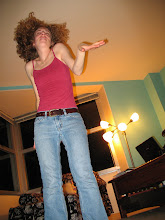Saturday, September 18, 2010
Men Akimbo
Sunday, September 12, 2010
Glamour Travel
My first business trip ever was to Gainesville, Florida followed by a jaunt to Des Moines, Iowa to see the site of a sculpture park under construction. Interesting? Absolutely. Glamorous? Not very. Last week, I got sent to Venice to wrangle media at one of the national pavilions. Interesting? Absolutely. Glamorous? Yes very (if you ignore the mosquito-bite welts I got from sitting outside the Pavilion all day).
I have a strict personal rule that I won't write about clients. And I won't break it now. However, I do want to share the experience of visiting Venice for the first time. It's a beautiful place and a puzzling one—geographically and culturally.
Amazingly, everyone can give you directions in English. Venice is an island for tourists. I learned that if I said my few Italian phrases with enough sweet vigor and my thick American accent, the stranger/waiter/shopkeeper I was speaking with would take pity on me and speak in English. In fact, I'm almost a little disappointed that I only had one language mishap. I was in a cafe waiting for a meeting to start and I heard the waiter deliver to the table behind me, "una Coca Cola." Fantastic, I thought to myself: I don't have to order water or coffee (the only things I knew the Italian words for). So the waiter comes over and I give him a big smile and say, "Prego, una Sprite [please, a Sprite]." He looks slightly befuddled and returns a few minutes later with a luridly orange drink with an orange slice and an olive floating in it. I'm so hot and thirsty that I shrug, say "grazie," and take a huge swig. It was so bitter that I nearly spit it out. When I told the ladies at the Peggy Guggenheim Collection this story later they howled with laughter. I had unwittingly ordered Venice's famed "spritz"--a soda and campari cocktail.
What I found thought provoking about the city was its sense of self. I felt like I was walking through a very large movie set. My American sensibility searched for dynamism, a sense that the past, present, and future all had a place on the sinking isles. Rather, it’s identity as a tourist destination has caused it to be frozen in time. Preserved for the very tourists who stop in for a few days hungry for experience and then who move on to the next experience.
The US, so young in comparison, seems so much more enchanted with its own past and celebrating it. We have markers everywhere talking about significant people or events. We have statues in most of our public parks and markers to our wars. That's largely missing in Venice--not that I could have read them if they existed. Still, I wanted to leave with that sense of history and veneration for the past.
Tuesday, September 7, 2010
Terrified at the Arsenale
I have been moved, puzzled, bewildered, and awed by works of art. Until last week, I had never been terrified by a work of art. Imagine a pitch black gallery, light from the gallery leading into it illuminates the eight large columns that run down the center in pairs. Jumping, switching, writhing electric wires snap and crackle between them. It’s mesmerizing and terrifying. Those are live wires. How can you have live wires in an art installation?
At the end of the gallery was a tiny, backlit doorway. There were more galleries to see, but I couldn’t tell how much I actually wanted to see them if it meant walking next to the wires. So, I simply stood and looked some more, forcing my rising panic down. Upon closer examination, the light I thought was coming from the wires was coming from strobe lights mounted on top of the columns. I slowly started to edge my way along the gallery wall and as I did my feet squelched. The floor was damp. Where on earth did this water come from? The wires weren’t wires at all. They were hoses. The snapping and crackling sounds I heard were water hitting the rubber floor. The strobe lights reflecting off the water created the electric effect.
I was relieved and chastened and I hated the piece. I felt manipulated and silly. But I couldn’t stop thinking about it over the next few days and when people asked me about impressions of the Arsenale, I always returned to that piece and shared my chagrin about being duped. I’ve actually come to appreciate the piece and admire its cleverness and ability to play on my expectations. Only after reading reviews of the Venice Architecture Biennale did I realize the piece was titled Split Second House and it was created by Olafur Eliasson. If I had known the artist I might not have been so shaken when first viewing the work, Eliasson’s obsession with water is well known. But then, I might not have had such a pure reaction.
